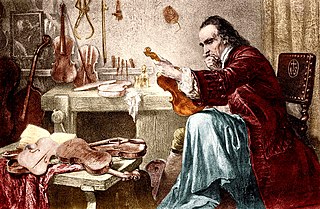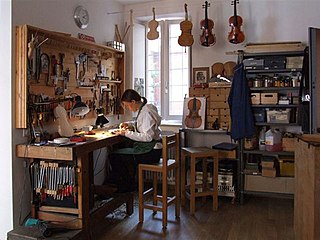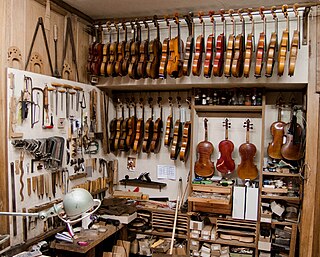Roy Courtnall (born Roy Shapiro) artist (painter and sculptor), luthier, author, teacher and lecturer in musical instrument technology. [1]
Roy Courtnall (born Roy Shapiro) artist (painter and sculptor), luthier, author, teacher and lecturer in musical instrument technology. [1]
At the age of 18 he relocated from his birth place in South Africa to the United Kingdom, studying for A levels at Abbotsholme School in Derbyshire (1972–73), before attending the University of London Goldsmiths College for a BA (Hons) degree in Fine Art Sculpture. It was during this period that his interest in building stringed musical instruments arose and he adopted Courtnall as a professional name, being a reference to the family name of his British great-grandfather who had taught him woodwork as a child. [2] A family background in education may have encouraged his own interest in teaching guitar making as well as making instruments himself; his mother, Sonia Machanick, was an educational psychologist who founded Japari School, a special school in Johannesburg and his father, Hillel Abbe Shapiro was Professor of Forensic Medicine at the University of South Africa.
GUITAR: In 1994, Courtnall was commissioned by the Newark School of Violin Making [3] in the United Kingdom to write the syllabus and set up a new course in Classical Guitar Making. After an initial intake of twelve students, the course rapidly expanded to become the leading vocational course in guitar making in the United Kingdom, now awarding a BA (Hons) Musical Instrument Craft qualification through the University of Hull. In 2008 he retired from Newark College.
Courtnall's work was initially focused on understanding and building instruments in the Spanish classical guitar tradition begun by Antonio de Torres during the 19th century and later perfected by Hermann Hauser, Daniel Friederich and Jose Romanillos. He then worked closely with the guitarist Rob Johns, to develop a lattice-braced concert guitar, influenced by, but not quite in the same vein as the Australian luthier Greg Smallman. [4]
FINE ART (PAINTING): In recent years he has returned to his original interest in fine art - in particular, painting; being mostly still lifes in the Realism tradition, using his birth name of Roy Shapiro: https://royshapiroart.com/ He has exhibited at the Royal Academy Summer Exhibition, the Royal Society of British Artists (Mall Galleries London) and the Royal Birmingham Society of Artists.
Courtnall's first book; Making Master Guitars, is a practical guide and historical summary of leading luthiers of the 19th and 20th centuries, enabling readers to make reasonably close replicas of their instruments. It includes detailed working drawings and plans of guitars by Antonio de Torres, Hermann Hauser, Robert Bouchet, Ignacio Fleta, Santos Hernandez, Hernandez and Aguado, Daniel Friederich and Jose Romanillos. In a review for Classical Guitar magazine, luthiers, Lipkin and Algranati, concluded that Courtnall had "combined the detailed work of the scholar with the practical insights of the craftsman." [5] The book has since been translated into French [6] and Japanese. [7]
His second book, The Art of Violin Making, was co-written with the violin maker Chris Johnson [8] and regarded by The Strad magazine as a "major contribution" to the violin-making bookshelf. [9] It includes a foreword by Lord Yehudi Menuhin, who refers to the book as "Exhaustive in its detailed exposition of the process of construction, conceived as it is, by two disciples of a distinguished English achievement - the Newark School of Violin Making". The book follows a similar format to Making Master Guitars and is closely based on the violin making method taught at the Newark School. It has been translated into Chinese. [10]
A mandolin is a stringed musical instrument in the lute family and is generally plucked with a pick. It most commonly has four courses of doubled strings tuned in unison, thus giving a total of eight strings. A variety of string types are used, with steel strings being the most common and usually the least expensive. The courses are typically tuned in an interval of perfect fifths, with the same tuning as a violin. Also, like the violin, it is the soprano member of a family that includes the mandola, octave mandolin, mandocello and mandobass.

Antonio Stradivari was an Italian luthier and a craftsman of string instruments such as violins, cellos, guitars, violas and harps. The Latinized form of his surname, Stradivarius, as well as the colloquial Strad are terms often used to refer to his instruments. It is estimated that Stradivari produced 1,116 instruments, of which 960 were violins. Around 650 instruments survive, including 450 to 512 violins. His instruments are considered some of the finest ever made, and are extremely valuable collector's items.

A Stradivarius is one of the violins, violas, cellos and other string instruments built by members of the Italian family Stradivari, particularly Antonio Stradivari, during the 17th and 18th centuries. They are considered some of the finest instruments ever made, and are extremely valuable collector's items.

A luthier is a craftsperson who builds or repairs string instruments that have a neck and a sound box.

Antonio de Torres Jurado was a Spanish guitarist and luthier, and "the most important Spanish guitar maker of the 19th century."

Making an instrument of the violin family, also called lutherie, may be done in different ways, many of which have changed very little in nearly 500 years since the first violins were made. Some violins, called "bench-made" instruments, are made by a single individual, either a master maker or an advanced amateur, working alone. Several people may participate in the making of a "shop-made" instrument, working under the supervision of a master. This was the preferred method of old violin makers who always put their names on violins crafted by their apprentices. Various levels of "trade violin" exist, often mass-produced by workers who each focus on a small part of the overall job, with or without the aid of machinery.
A person who is specialized in the making of stringed instruments such as guitars, lutes and violins is called a luthier.

Matteo Goffriller (1659–1742) was a Venetian luthier, particularly noted for the quality of his cellos. He was active between 1685–1735 and was the founder of the "Venetian School" of luthiers, during a time when Venice was one of the most important centers of musical activity in the world.
Samuel Zygmuntowicz is a contemporary luthier and is widely regarded as one of the finest violin makers of his generation. He began his instrument making training at age 13, and studied making and restoration under Peter Prier, Carl Becker and René Morel. Since 1985 he has been based in Brooklyn, New York. His early work demonstrates expert skill as a copyist of classic instruments. Later work includes personal models informed by intensive advanced research. Findings from this research have been published in numerous print and digital media. Zygmuntowicz is an active fiddler, playing with several folk music groups. His playing can be heard on the recordings Grand Picnic, and Jump When the Trumpets Blow.

Giuseppe Fiorini (1861–1934) was an Italian luthier and is considered one of the most important Italian violin makers. He built his first instrument at the age of 16 while working in Bologna. He established Rieger and Fiorini in Germany from 1888, then lived in Zurich during World War 1 and Rome from 1923.
Gregg T. Alf is a prominent contemporary American violin maker based in Ann Arbor, Michigan.

Raffaele Fiorini, was an influential Italian violin maker.
Hermann Hauser Sr. was a German luthier. He worked in Munich and later in the Bavarian Reisbach. Guitar models by Hermann Hauser Sr. included the Vienna Model and the Munich Model, the Terz-Guitar, the Prim-Guitar and the Fifth-Bass Guitar (Quintbass). But it was his innovations based on the designs of Antonio de Torres for which he "is generally considered to have been the greatest guitar maker outside Spain." His Torres-based instruments are historically important, having profoundly influenced classical guitar builders and performing artists of the modern era. Andres Segovia described the 1937 Hauser Sr. with which he performed and recorded from 1938 to 1962 as the "greatest guitar of our epoch," and it is one of two Hauser Sr. guitars in the Metropolitan Museum of Art, New York collection. Met curator of musical instruments Jayson Dobney described Segovia's 1937 Hauser as having "changed music history": "This guitar, as much as Andre Segovia, established classical guitar playing." The British guitarist and lute player Julian Bream described Hausers as "the very essence of classicism in guitar sound" and recorded at least eight of his albums using Hauser Sr. Torres models of various vintages. Renowned antiquarian dealers Christie's and Brompton's Fine & Rare Instruments regularly offer Hauser Sr. guitars at auction. Hauser's Torres model is "one of the most copied guitars of today," with master luthiers such as Simon Ambridge (England), German Vazquez Rubio and Brian Cohen (UK), Paolo Coriani (Italy) and Francisco Navarro Garcia (Mexico) among many others, as well as popular manufacturers such as Cordoba, all offering Hauser-inspired models.

Nicola Amati, Nicolò Amati or Nicolao Amati was an Italian master luthier from Cremona, Italy. Amati is one of the most well-known luthiers from the Casa Amati. He was the teacher of illustrious Cremonese School luthiers such as Andrea Guarneri and Giovanni Battista Rogeri. While no clear documentation exists for their being apprentices in his shop, Amati may also have apprenticed Antonio Stradivari, Francesco Rugeri, and Jacob Stainer, as their work is heavily influenced by Amati.
Andrea Tacchi is an Italian luthier who specializes in classical guitar making.
The Universal Dictionary of Violin & Bow Makers is a widely cited reference work providing information on approximately 9,000 violin makers. The work is based on the extensive notes of violinist and composer William Henley (1874-1957). Henley had in his youth studied with August Wilhelmj, and later became a professor of composition and principal of the violin at the Royal Academy in London. Having played violins from many manufacturers, Henley sought to compile a comprehensive list evaluating violin and bow makers. After Henley's death in 1957, dealer Cyril Woodcock (1897–1980) completed and published the work based on Henley's unfinished notes. The work was first published in five volumes in 1959 and 1960, and republished in a single volume in 1973.
Mario Maccaferri (1900–1993) was an Italian luthier, classical guitarist, businessman, and inventor. He is noted for designing the guitar favored by jazz musician Django Reinhardt, and for designing plastic clothespins, plastic bath and kitchen tiles and the plastic Islander ukulele which sold millions of copies in the mid-1900s. From 1939 he lived and worked in the United States. As of 2016 his daughter Elaine still runs the family company French American Reeds Inc.
Étienne Vatelot was a French luthier.

Tullio Bassi is an Italian violin maker. He made instruments for members of a number of renowned orchestras. He studies and follows the techniques of the renowned luthier, Antonio Stradivari.
Manuel Ramírez was a Spanish luthier.
{{cite book}}: CS1 maint: others (link){{cite book}}: CS1 maint: others (link)